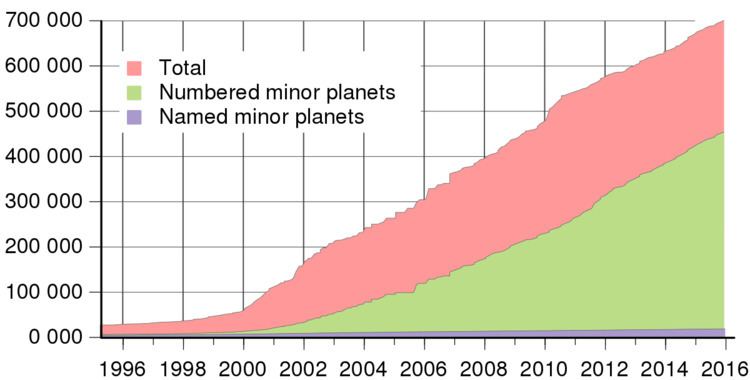1873 1922 1899 1987 1911 2000 | 1892 false positive 1901 1987 1911 1988 | |
 | ||
Lost minor planets are minor planets that observers lose track of due to too short an observation arc to accurately predict the future location of the minor planet. Many of the asteroids that were discovered early were lost and rediscovered in the 1980s and 1990s, but a number of minor planets continue to be lost. By some definitions, thousands, if not tens of thousands observed minor planets are lost—they cannot be found by pointing an appropriate telescope at their predicted location, because the uncertainty in their predicted orbit is too large or they are currently too faint to be detected.
Contents
Some minor planets and comets discovered in previous decades were "lost" because the observational data obtained was insufficient to determine a reliable orbit. Without this information, astronomers would not know where to look for the object at future dates. Occasionally, a "newly discovered" object turns out to be a rediscovery of a previously lost object. This can be determined by calculating the "new" object's orbit (once it is firmly known) backwards and checking its past positions against those previously recorded for the lost object. This may greatly extend the observation arc, thus fixing the orbit much more precisely. For lost comets the back orbit calculations are especially tricky because of nongravitational forces that can affect their orbits, such as emission of jets of gas from the comet nucleus. However, Brian G. Marsden has specialized in calculating such nongravitational forces. Notably, he successfully predicted the 1992 return of the once-lost periodic comet Swift–Tuttle.
Overview
This is a small selection of some early lost or notable asteroids with their discovery and rediscovery dates. (A more detailed description for some of these minor planets can be found in the following sections). The true number of lost asteroids may be over 150,000. There are also about 30,000 unnumbered bodies with a condition code of U = 9, indicating the highest possible uncertainty of their orbit determination. Many of these bodies have been observed years if not decades ago and must be considered lost. There are also more than a thousand near-Earth objects (NEOs) with an observation arc of one or two days only.
20th-century recoveries
The number of asteroids that were only observed once and not re-observed grew throughout the 19th and 20th centuries, but improved telescopes, searches, and detection techniques led to resolution of most of these cases between 1970 and 2000. There are earlier examples also, such as 132 Aethra, which was lost between 1873 and 1922.
1980s and 1990s
Leif Kahl Kristensen at the University of Aarhus rediscovered 452 Hamiltonia and 1537 Transylvania, along with numerous other small objects, in 1981. At the time these results were published, only the nine numbered minor planets 330 Adalberta, 473 Nolli, 719 Albert, 724 Hapag, 843 Nicolaia, 878 Mildred, 1009 Sirene, 1026 Ingrid, and 1179 Mally remained unobserved since their discoveries:
